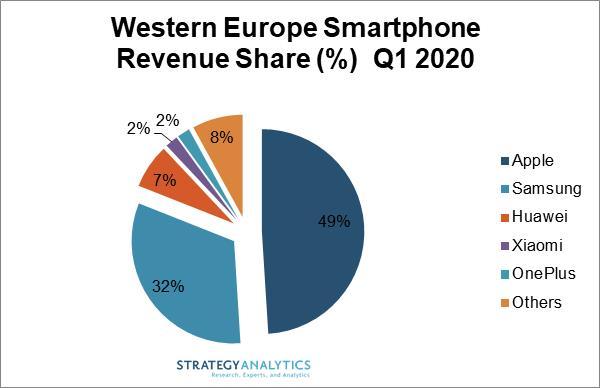News: Markets
12 June 2020
Western Europe smartphone revenue dips 10% to $10bn in Q1
Despite the average selling price (ASP) nudging upwards, wholesale revenue for smartphones in the Western European region in first-quarter 2020 fell by 10% year-on-year due to COVID-19-limited demand, according to Strategy Analytics’ Wireless Smartphone Strategies (WSS) service report ‘Smartphone Vendor ASP and Revenue Share by Region: Q1 2020’.

Picture: Western Europe smartphone revenue share percentage Q1/2020.
Western Europe is the third largest region by value globally. Apple and Samsung continue to have a duopoly, as the two collectively account for more than 80% of overall revenue in the region. Huawei was ranked third with 7% of the wholesale revenue share.
In Western Europe, the most hotly contested battle is just behind third-place Huawei, which continued to see its share decline due to the ban on Google mobile services globally. Xiaomi and OnePlus are close behind in the chasing pack and positioning for both volume and value share gains with ramped-up marketing and promotion and expanded portfolios.
“Xiaomi has had success in several Western European markets and notably is seeing strong demand for its Redmi Note 8 and Redmi 8 models,” says associate director Boris Metodiev. “OnePlus - with recent growth in Norway, Switzerland and Netherlands - is a rising star. Oppo is currently at modest volume and value share, but its recent ranging success with Vodafone will make a huge difference moving forward,” he adds.
“As Europe begins to emerge from the COVID-19 ground stop and with 5G volumes waiting in the wings for 2021, the market will become much more competitive,” believes Neil Mawston, executive director of Strategy Analytics’ the Wireless Smartphone Strategies (WSS) service. “Legacy brands Motorola, LG and even Sony from the 2010s will continue to struggle as they try to balance a desire for premium-tier presence with the reality that their brands have questionable ability to support this aspiration anymore,” he adds.
“In a commodity market the two key battlegrounds will be marketing and price,” continues Mawston. “These brands lack the scale globally to compete on price (for long) and their marketing cost per unit needed to even make a ripple in the smartphone pond will be huge. Creative marketing to segments of the market that are open to the brand and willing to switch from the big two is needed.”
Smartphone shipments fall 17% year-on-year in Q1/2020 to 275 million
Samsung and Huawei capture 68% share of global 5G smartphone shipments in Q1









